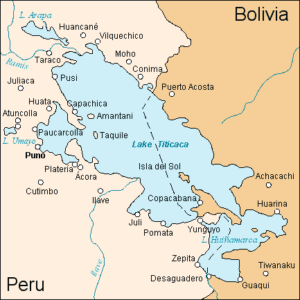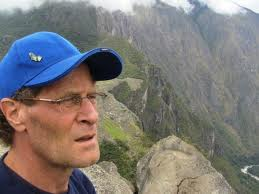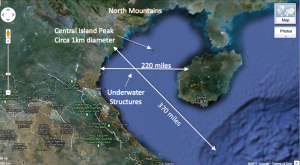Peru
Caral
Caral is an important site in the Supe Valley of central Peru near the coast and was part of the Norte Chico civilisation. It was occupied during the third millennium BC, although some push that back as far as the fourth millennium. Caral is claimed to be the oldest urban settlement in the Americas(a), although other sites in the region may challenge that. Arthur D. Faram has written a petroglyphic study of Caral(c).
A 2021 article from the History Channel suggests a date of around 2600 BC for the Caral complex and that it was abandoned about a thousand years later(d).
The 600-hectare site includes a pyramid complex that may have preceded those of the Egyptians. An early quipu was also found at the site suggesting some form of continuity with the later Inca civilisation.
In the 1950s, further south, in the Manchay Valley near the capital Lima, Karola Siebert was convinced that she had found Atlantean remains, while further south again, over the border in Bolivia we have Jim Allen’s chosen location for Atlantis near Lake Poopó.
A French website(b) has on offer the strange idea that the longitude of Caral in Peru and that of Xian in China and their respective relationships with the Prime Meridian at Greenwich and the longitude of Giza have some bearing on the location of Atlantis, which the author, Fabien Pardo, places in the Antarctic!
I reject all South American locations as possibly Atlantean and do so principally because the idea of an attack on Athens being launched from the west coast of South America, thousands of years ago, is, to put it kindly, just silly. However, it is quite clear that this region has had a fascinating prehistory and should keep archaeologists busy for generations to come.
(a) https://www.bibliotecapleyades.net/arqueologia/caral.htm
(b) ATLANTIS AND THE GREENWICH’S MERIDIAN – Site du livre – Pour Eux v1.618 – (archive.org) *
(c) https://migration-diffusion.info/article.php?id=344
(d) This Little-Known Peruvian Civilization Built Pyramids as Old as Ancient Egypt’s – HISTORY
Lake Titicaca
Lake Titicaca is the largest lake in South America and at over three kilometres is arguably the highest navigable lake in the world**, shared by Peru and Bolivia. In spite of claims to the  contrary it is a fresh water lake, but is slowly reducing in size due reduced inflow from the retreating Andean glaciers. Lake Poopó to the south has now dried out completely(a).
contrary it is a fresh water lake, but is slowly reducing in size due reduced inflow from the retreating Andean glaciers. Lake Poopó to the south has now dried out completely(a).
***Karakul in Tajikistan exists at 4,000 metres and “is so salty, it’s almost impossible to navigate a boat on it without capsizing due to the vessel riding so far out of the water.”(e)*
To the south of the lake are remarkable archaeological remains of Tiwanaku and the equally exciting Puma Punku. Both sites have produced some extreme theories regarding the builders of these monuments, their technology level and the date of their construction. Arthur Posnansky, followed by Kurt Bilau have proposed a date of circa 9500 BC as the date of fall of Tiwanaku. There are also reports of pre-Incan structures submerged in Titicaca(d) .
South of Lake Titicaca, near Lake Poopó is Pampa Aullagus, a site identified by Jim Allen as the location of Plato’s Atlantis. While there is little doubt that advanced cultures existed around Titicaca, linking the region to Plato’s story is stretching credibility to its limits. I have already argued in respect of Jim Allen’s Andean theory, that the idea of an invasion of the eastern Mediterranean by an army from the west side of South America is untenable. That they would try it in reed boats like those of Titicaca is equally daft. Then, that this mighty army from ten regions of South America were defeated by the small city-state of Athens is just as laughable.
Equally questionable is the idea that there was a Sumerian presence around Titicaca, in relation to which Clyde Winters quotes(b) James Bailey as well as Ruth and A. Hyatt Verrill in supporting the idea that Lake Manu in Sumerian tradition was in fact Titicaca. The controversial(c) Fuente Magna bowl is also offered as evidence of this idea.
(c) https://www.jasoncolavito.com/blog/the-fuente-magna-bowl-still-fake
*(e) https://www.bbc.com/travel/story/20190207-asias-dead-lake-where-boats-cant-float*
Two Crops a Year
Two Crops a year is one of the characteristics of Atlantean agriculture according to Plato (Critias 118e).
The North African climate was slightly wetter at the time of Hannibal (2nd & 3rd cent. BC), later, Algeria, Egypt and particularly Tunisia, were the ‘breadbasket’ of Rome(b) and may also have been so for the Atlanteans who earlier had control from North Africa to Tyrrhenia! Even today well-irrigated plains in Tunisia can produce two crops a year, usually planted with the autumnal rains and harvested in the early spring and again planted in the spring and harvested in late summer. The Berbers of Morocco produce two crops a year—cereals in winter and vegetables in summer(a).
It is worth noting that Mago, the Carthaginian author of a 28-book work on the agricultural practices of North Africa. had his books brought to Rome after the destruction of Carthage in 146 BC, where they were translated from Punic into Latin and Greek and were widely quoted. It is clear that Mago’s work was a reflection of a highly developed agricultural society in that region, a description that could also be applied to Plato’s Atlantis!
Although two crops are possible annually in other parts of the world, I must emphasise that North Africa is the only part of the Atlantean territory referred to by Plato (Timaeus 25b) that was so productive and continued to be so until the Romans, who depended on it along with Egypt to feed Rome.
>James Bailey who advocated an American location for Atlantis refers [150.63] to the irrigation systems of ancient Mexico and the ability to raise three crops a year in Mexico and the coastal plains of Peru as all echoes of Plato’s description of Atlantis.<
Machu Picchu
Machu Picchu is generally accepted to have been an Incan retreat, built in the middle of the 15th century on a barely accessible mountaintop of Peru about fifty miles northwest of Cuzco. It was apparently abandoned a century later and only brought to the attention of the outside world in 1911 when it was rediscovered by Hiram Bingham III (1875-1956).
In 2021 the use of a more advanced dating method (accelerator mass spectrometry) has pushed back the earliest date for the site by a couple of decades to 1420 AD(j).
Mark Adams, the American writer, wrote an account of his retracing of Bingham’s journey to Machu Picchu[976]. Along with the narrative of his pilgrimage, Adams has also interwoven a valuable history of the region.
In 2013, a Polish-Peruvian team, while exploring a previously unexcavated building on the site, claimed to have discovered that the structure was astronomically aligned(a). The following year saw a newly discovered section of the Inca Road, which leads to Machu Picchu, announced by the Andina News Agency(c).
In July 2016, it was reported that what are considered pre-Inca petroglyphs were discovered in the Machu Picchu region(d)(e). Research is proceeding.
The siting of the sanctuary has been something of a mystery, Recent research suggests that the existence of geological faults that lie beneath it may offer some of the answers. Rualdo Menegat, a Brazilian geologist, presented a paper to the Geological Society of America’s annual meeting in Phoenix, in which he claims that the Incas deliberately chose to build Machu Picchu and some of their cities where tectonic faults meet!(h)
It was revealed in 2019 that work had commenced on the building of a new international airport to service Machu Picchu, a development that has been vigorously opposed as a threat to the already fragile site. It is worth noting that in 2017, 1.5 million visitors, nearly twice the limit recommended by UNESCO, came to Machu Picchu(g).
Also in 2019, it was announced that an even older Inca site was discovered 1,500 metres higher than Machu Picchu using LiDar(i).
Some pathetic attempts have been made to link Machu Picchu with Atlantis. One of them claims that “This was the (summer?) residence of the continental governor, who at the time of the destruction of Atlantis was a woman.”(b) Others, such as Rand Flem-Ath along with the late Colin Wilson[063], as well as Jim Alison, have included the Andean site in proposed global grids linking prehistoric sites.
A less-known Inca site is that of Choquequirao(f), sometimes referred to as the ‘sister’ of Machu Picchu. Only a third of the site has been excavated so far.
>In March 2022, it was reported that “a new academic paper argues that since its rediscovery more than a century ago, the site has been known by the wrong name. A Peruvian historian and a leading US archaeologist argue that the Unesco world heritage site was known by its Inca inhabitants as Huayna Picchu – the name of a peak overlooking the ruins – or simply Picchu.”(l)<
Charles R. Kos expressed a belief “that Macchu(sic) Picchu in Peru which is held to be ‘Inca’ is in fact, I am fairly certain, an Irish Monastery from the Dark Ages.”(k)
(a) https://atlantipedia.ie/samples/archive-2330/
(h) https://www.sciencedaily.com/releases/2019/09/190923140814.htm
(j) Machu Picchu older than expected, study reveals | YaleNews
(l) Machu Picchu: Inca site ‘has gone by wrong name for over 100 years’ | Archaeology | The Guardian *
Foerster, Brien *
Brien Foerster is an American writer who now lives in Cuzco, the former Inca capital in Peru. He has studied the  ancient cultures of the Andes and believes that many predated the Incas and had advanced technologies that permitted the precise drilling of stone(a). His fully illustrated Kindle book, Lost Ancient Technology of Peru and Bolivia[0923], provides many examples. The book is worth purchasing for the images alone. There is now a video(d) that complements Foerster’s book.
ancient cultures of the Andes and believes that many predated the Incas and had advanced technologies that permitted the precise drilling of stone(a). His fully illustrated Kindle book, Lost Ancient Technology of Peru and Bolivia[0923], provides many examples. The book is worth purchasing for the images alone. There is now a video(d) that complements Foerster’s book.
Foerster has now studied the stonework of the ancient Egyptians and like Chris Dunn concluded that their level of accuracy could not have been achieved without possession of a high technology, now lost(i). He has expanded on this in his 2014 book, Lost Ancient Technology of Egypt[1487].
However, Foerester has recently stepped out of line when he apparently chipped fragments from stones at the Bolivian Puma Punku site with a view to having them tested for age. The laboratory refused to test the fragments as Foerester did not have the appropriate export document from Bolivia(e). It would appear that Foerster is either stupid or criminally irresponsible or both. Apparently, Foerester now claims that the details of this report are inaccurate and may be libellous(f).
This episode is reminiscent of the two German scientists who in 2013 were wrongfully accused of removing part of the ‘Vyse cartouche’ in the Great Pyramid and illegally smuggling it out of Egypt. This was subsequently shown to be a false claim by Zahi Hawass(l).
Elsewhere with regard to Atlantis, he claims “the most plausible idea is that Atlantis was not a single land mass that sank, but was a series of smaller states in the Atlantic area 12,000 years ago.”
In recent interviews, Foerster has proposed that the story of Atlantis is based on an Ice Age civilisation(g). His latest attention-seeking claim is that the Maya visited ancient Egypt, a trip that had some form of Atlantis connection(h).
He has also co-authored with David Hatcher Childress a book on South American cranial deformation and elongated skulls. These are reminiscent of similar skulls found in Malta(c) and Egypt as well as elsewhere around the world and date back many thousands of years(b).
Carl Feagans’ website(j) has a number of articles that are highly critical of Foerster’s methods and motivation. Equally critical is a posting and comments on the newagefraud.org website(k).
(a) https://www.youtube.com/watch?v=xR7of1Lkef0
(b) https://www.atlasobscura.com/articles/head-space-artificial-cranial-deformation
(c) https://nexusilluminati.blogspot.ie/2013/03/ancient-elongated-skulls-and-cranial.html
(d) https://www.youtube.com/watch?v=HmK7Ng0eGV8
(h) https://verumetinventa.wordpress.com/2016/06/28/brien-foerster-good-evidence-of-maya-culture-in-egyptian-pyramids/ (offline October 2017)
(k) http://www.newagefraud.org/smf/index.php?topic=5345.0 *
(l) URGENT URGENT! BREAKING NEWS: EGYPT – Atlantisforschung.de (atlantisforschung-de.translate.goog)
Onffroy de Thoron, Enrique
Enrique Onffroy de Thoron was a French aristocrat whose family fled their homeland following the French Revolution(a). He was not Brazilian as claimed by Alexander Braghine. He travelled the world eventually settling in South America where he studied the language of the indigenous people of Peru. He later returned to France where he published the results of his research.
He believed that Atlantis was Phoenician and situated in America[0901]. According to Braghine, Onffroy de Thoron claimed that the Atlanteans along with the Andean Quichua tribe invaded Europe! Among his other strange conclusions (or should that be delusions?) was that the Carians of western Anatolia (Turkey) had populated the south-western shores of South America and that a Carian dynasty had once ruled in Quito (Ecuador)[156]!
*(a) https://web.archive.org/web/20160317092445/https://onffroy.com/2_7_Jamaica.html*
McMurrough-Mulhall, Marion
Marion McMurrough Mulhall (? -1922) was the wife of a famous Irish statistician, Michael George Mulhall (1838-1900) (his Dictionary of Statistics(b) was last published in 1970). She has written a number books, particularly about South America, but in 1911 she published Beginnings or Glimpses of Vanished Civilizations. In this interesting, if rather dated work of 136 pages, the author suggests that “The gods and goddesses of the ancient Greeks, the Phoenicians, the Hindoos, and the Scandinavians were simply the kings, queens, and heroes of Atlantis, and the acts attributed to them in mythology are a confused recollection of real historical events. The mythology of Egypt and Peru represented the original religion of Atlantis, which was sun worship. The oldest colonies from Atlantis were probably the Akkadians and Sumerians, who are thought as yet, according to Messrs.King and Halpto have been the original founders of the Babylonian and Egyptian civilization. The implements of the ” Bronze Age ” of Europe were derived from Atlantis. The Atlantians were also the first manufacturers of iron, and we know that Parthelon, when he visited Ireland, came in iron vessels of occidental blackness.”
The author discusses a number of aspects of ancient history including Atlantic landbridges. She argues that Ireland was Plutarch’s Ogygia and also comments on Lemuria and Easter Island. The full text can be read online(a).
(a) https://archive.org/stream/beginningsorglim00mulhrich#page/118/mode/1up
Garcia, Gregorio
Gregorio García (1556/61-1627) was a Spanish Dominican who worked in Peru for some years and in 1607 published Origen de los indios del Nuevo mundo e Indias occidentals[1400], in which he reviewed all the then current theories regarding the origins of native Americans.
Ronald Fritze notes in his Invented Knowledge[0709] that Garcia included the possibility that either America was Atlantis or the home of refugees from there. Andrés Gonzáles de Barcia (1673-1743), another Spanish historian, published an expanded edition of García’s book in 1729
Cunningham, Derek
Derek Cunningham is the author of a website(a) with an extensive amount of material devoted to archaeoastronomy. His core idea is that there existed in ancient times a World Map based on the the Cygnus constellation, echoing some of Andrew Collins’ work[075].
Included on his site is an article that somehow links a painting, allegedly a map, in the Lascaux Cave with a location in Viet Nam’s Gulf of Tonkin, which Cunningham describes as having “dimensions and geographical features similar to Plato’s description of Atlantis.” He later adds that “of all the various locations proposed, this is the only site that appears consistent with Plato’s description.” As a layman I found the article and the site in general, totally confusing, forcing me to lie down in a darkened room.
However, I cannot deny that Cunningham has put a lot of work into his site and he does have fans(b), but his ideas are too ‘way out’ for me.
His most recent ‘discoveries’(c) include an association of the layout of the Stonehenge complex with the Milky Way!
Cunningham has published his theories in two books, Khyung The Stone Age Astronaut[954] and 400,000 Years of Stone Age Science[955].
He later extended his studies to the remarkable terraced walls of Sacsayhuamán near Cuzco in Peru. In a 2014 illustrated article in Popular Archaeology online magazine, he claimed that the angles of the adjoining ends or sides of the irregular yet tightly fitting stones have astronomical significance!
Cunningham, has now turned his attention to angles inscribed at ancient sites, which he now claims can be associated with astronomical features and events. His extensive article(e) on the Migration and Diffusion website deals with a great many numbers that I shall leave others to evaluate.
(a) See: https://www.midnightsciencejournal.com
(b) https://thothistheibis.wordpress.com/tag/brodgar-complex/
(c) See: https://atlantipedia.ie/samples/archive-3055/
(e) https://www.migration-diffusion.info/article.php?year=2016&id=486
Cabrera, Javier (L)
 Javier Cabrera (1924-2001) was a respected Peruvian physician and founder of the medical school of Ica National University. Outside of Peru he is better known as the keeper of the controversial Ica Stones which he collected and studied over a forty-year period. He never wavered in his belief of their authenticity.
Javier Cabrera (1924-2001) was a respected Peruvian physician and founder of the medical school of Ica National University. Outside of Peru he is better known as the keeper of the controversial Ica Stones which he collected and studied over a forty-year period. He never wavered in his belief of their authenticity.



